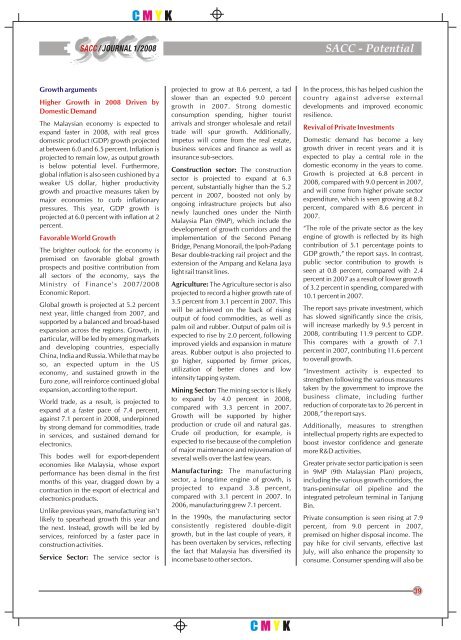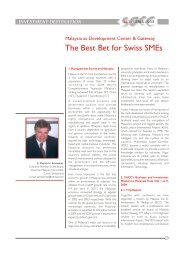Malaysia - Kriesemer
Malaysia - Kriesemer
Malaysia - Kriesemer
You also want an ePaper? Increase the reach of your titles
YUMPU automatically turns print PDFs into web optimized ePapers that Google loves.
Growth arguments<br />
C M Y K<br />
SACC / JOURNAL 1/2008<br />
Higher Growth in 2008 Driven by<br />
Domestic Demand<br />
projected to grow at 8.6 percent, a tad In the process, this has helped cushion the<br />
slower than an expected 9.0 percent country against adverse external<br />
growth in 2007. Strong domestic developments and improved economic<br />
consumption spending, higher tourist resilience.<br />
arrivals and stronger wholesale and retail<br />
trade will spur growth. Additionally,<br />
Revival of Private Investments<br />
impetus will come from the real estate, Domestic demand has become a key<br />
business services and finance as well as growth driver in recent years and it is<br />
insurance sub-sectors.<br />
expected to play a central role in the<br />
domestic economy in the years to come.<br />
The <strong>Malaysia</strong>n economy is expected to<br />
expand faster in 2008, with real gross<br />
domestic product (GDP) growth projected<br />
at between 6.0 and 6.5 percent. Inflation is<br />
projected to remain low, as output growth<br />
is below potential level. Furthermore,<br />
global inflation is also seen cushioned by a<br />
weaker US dollar, higher productivity<br />
growth and proactive measures taken by<br />
major economies to curb inflationary<br />
pressures. This year, GDP growth is<br />
projected at 6.0 percent with inflation at 2<br />
percent.<br />
Construction sector: The construction<br />
sector is projected to expand at 6.3<br />
percent, substantially higher than the 5.2<br />
percent in 2007, boosted not only by<br />
ongoing infrastructure projects but also<br />
newly launched ones under the Ninth<br />
<strong>Malaysia</strong> Plan (9MP), which include the<br />
development of growth corridors and the<br />
Growth is projected at 6.8 percent in<br />
2008, compared with 9.0 percent in 2007,<br />
and will come from higher private sector<br />
expenditure, which is seen growing at 8.2<br />
percent, compared with 8.6 percent in<br />
2007.<br />
“The role of the private sector as the key<br />
Favorable World Growth<br />
implementation of the Second Penang engine of growth is reflected by its high<br />
The brighter outlook for the economy is<br />
premised on favorable global growth<br />
prospects and positive contribution from<br />
all sectors of the economy, says the<br />
Ministry of Finance's 2007/2008<br />
Economic Report.<br />
Global growth is projected at 5.2 percent<br />
next year, little changed from 2007, and<br />
supported by a balanced and broad-based<br />
expansion across the regions. Growth, in<br />
particular, will be led by emerging markets<br />
and developing countries, especially<br />
China, India and Russia. While that may be<br />
so, an expected upturn in the US<br />
economy, and sustained growth in the<br />
Euro zone, will reinforce continued global<br />
Bridge, Penang Monorail, the Ipoh-Padang<br />
Besar double-tracking rail project and the<br />
extension of the Ampang and Kelana Jaya<br />
light rail transit lines.<br />
Agriculture: The Agriculture sector is also<br />
projected to record a higher growth rate of<br />
3.5 percent from 3.1 percent in 2007. This<br />
will be achieved on the back of rising<br />
output of food commodities, as well as<br />
palm oil and rubber. Output of palm oil is<br />
expected to rise by 2.0 percent, following<br />
improved yields and expansion in mature<br />
areas. Rubber output is also projected to<br />
go higher, supported by firmer prices,<br />
utilization of better clones and low<br />
intensity tapping system.<br />
contribution of 5.1 percentage points to<br />
GDP growth,” the report says. In contrast,<br />
public sector contribution to growth is<br />
seen at 0.8 percent, compared with 2.4<br />
percent in 2007 as a result of lower growth<br />
of 3.2 percent in spending, compared with<br />
10.1 percent in 2007.<br />
The report says private investment, which<br />
has slowed significantly since the crisis,<br />
will increase markedly by 9.5 percent in<br />
2008, contributing 11.9 percent to GDP.<br />
This compares with a growth of 7.1<br />
percent in 2007, contributing 11.6 percent<br />
to overall growth.<br />
“Investment activity is expected to<br />
strengthen following the various measures<br />
expansion, according to the report.<br />
World trade, as a result, is projected to<br />
expand at a faster pace of 7.4 percent,<br />
against 7.1 percent in 2008, underpinned<br />
by strong demand for commodities, trade<br />
in services, and sustained demand for<br />
electronics.<br />
This bodes well for export-dependent<br />
economies like <strong>Malaysia</strong>, whose export<br />
performance has been dismal in the first<br />
months of this year, dragged down by a<br />
contraction in the export of electrical and<br />
electronics products.<br />
Unlike previous years, manufacturing isn't<br />
likely to spearhead growth this year and<br />
the next. Instead, growth will be led by<br />
services, reinforced by a faster pace in<br />
construction activities.<br />
Service Sector: The service sector is<br />
Mining Sector: The mining sector is likely<br />
to expand by 4.0 percent in 2008,<br />
compared with 3.3 percent in 2007.<br />
Growth will be supported by higher<br />
production or crude oil and natural gas.<br />
Crude oil production, for example, is<br />
expected to rise because of the completion<br />
of major maintenance and rejuvenation of<br />
several wells over the last few years.<br />
Manufacturing: The manufacturing<br />
sector, a long-time engine of growth, is<br />
projected to expand 3.8 percent,<br />
compared with 3.1 percent in 2007. In<br />
2006, manufacturing grew 7.1 percent.<br />
In the 1990s, the manufacturing sector<br />
consistently registered double-digit<br />
growth, but in the last couple of years, it<br />
has been overtaken by services, reflecting<br />
the fact that <strong>Malaysia</strong> has diversified its<br />
income base to other sectors.<br />
taken by the government to improve the<br />
business climate, including further<br />
reduction of corporate tax to 26 percent in<br />
2008,” the report says.<br />
Additionally, measures to strengthen<br />
intellectual property rights are expected to<br />
boost investor confidence and generate<br />
more R&D activities.<br />
Greater private sector participation is seen<br />
in 9MP (9th <strong>Malaysia</strong>n Plan) projects,<br />
including the various growth corridors, the<br />
trans-peninsular oil pipeline and the<br />
integrated petroleum terminal in Tanjung<br />
Bin.<br />
Private consumption is seen rising at 7.9<br />
percent, from 9.0 percent in 2007,<br />
premised on higher disposal income. The<br />
pay hike for civil servants, effective last<br />
July, will also enhance the propensity to<br />
consume. Consumer spending will also be<br />
C M Y K<br />
SACC - Potential<br />
39





